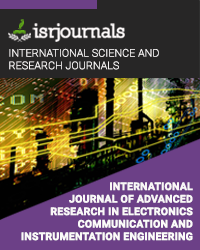design and development of pest image segmentation technique using soft computing algorithm
Pravin Kumar.S.K,Sumithra.M.G,Saranya.N
Published in International Journal of Advanced Research in Electronics, Communication & Instrumentation Engineering and Development
ISSN: 2347 -7210 Impact Factor:1.9 Volume:2 Issue:2 Year: 25 October,2014 Pages:29-33

Abstract
Image segmentation is a major step for automated object recognition systems. In many cases, image processing is affected by illumination conditions, random noise and environmental disturbances due to atmospheric pressure or temperature fluctuation. The quality of pest images is directly affected by atmosphere medium, pressure and temperature. This emphasizes the necessity of image segmentation, which divides an image into parts that have strong correlations with objects to reflect the actual information collected from the real world. Image segmentation is the most practical approach among virtually all automated image recognition systems. The performance of an image segmentation algorithm depends on its simplification of image. The different segmentation algorithms namely, fixed threshold, Experience threshold, Iteration method, OTSU method and fuzzy c-means segmentation [5] are implemented for pest images and they are compared using nonlinear assessment or the quantitative measures like gray level energy, entropy, and normalized mutual information. Out of the above methods the experimental results show that fuzzy c means clustering algorithm performs better than other methods in processing pest images. FCM based simulated annealing algorithm [2] provides better results than other intelligent techniques .
Kewords
segmentation, energy, entropy, Mutual information, simulated-annealing algorithm, fcm clustering
Reference
[1] Yan li, Chunlei Xia, Jangmyung lee, “Vision-based Pest Detection and Automatic Spray of Greenhouse plant,” IEEE International Symposium on Industrial Electronics, 2009. [2] XianYing Wang,Glenn Whitwell “Application of Simulated Annealing Fuzzy Clustering Algorithm for Cancer Diagnosis,”Nov-2004. [3] Somporn Chuai-aree , Chidchanok Lursinsap, FCM-“A Statistical Feature Classification of Text and Image Segmentation Method”-2006 [4] Dimitrios Moshou , Cédric Bravo , Jonathan West ,“Automatic detection of ‘yellow rust’ in wheat using reflectance measurements and neural networks,”April-2004 [5] Rumiana KrastevaFuzzy ,C-Means Clustering Bulgarian Hand-Printed Character Recognition Using Fuzzy C-Means Clustering-2002 [6] Li Zhijun , Zeng Fei, Wang Danqing, “Simulated Annealing and Genetic Algorithms Based for Image Segment with Partially Evolved Hopfield Neural Network,” IJCSNS International Journal of Computer Science and Network Security, VOL.6 No.7A, July 2006 [7] Lei Hui, Cheng Shi, Ao Min-si, “Application of an Improved Genetic Algorithm in Image Segmentation,” International Conference on Computer Science and Software Engineering-2008. [8] Stephen Gang Wu , Forrest Sheng Bao , Yu-Xuan Wang ,“A Leaf Recognition Algorithm for Plant Classification Using Probabilistic Neural Network,” [9] Dr.G.Padmavathi, M.Muthukumar, “Implementation and Comparision of Different Segmentation Algorithms used for Underwater Images Based on Nonlinear Objective Assessments,” ICACTE International Conference on Advanced Computer Theory and Engineering,July 2010

